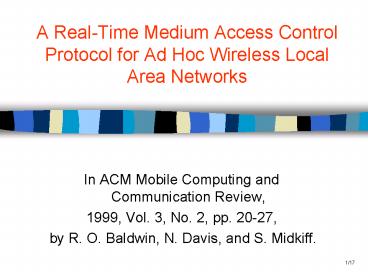In ACM Mobile Computing and Communication Review, - PowerPoint PPT Presentation
1 / 18
Title:
In ACM Mobile Computing and Communication Review,
Description:
A Real-Time Medium Access Control Protocol for Ad Hoc Wireless Local Area Networks ... avionics (????) traffic on Boeing 777. 14 /17. Mean Delay ... – PowerPoint PPT presentation
Number of Views:41
Avg rating:3.0/5.0
Title: In ACM Mobile Computing and Communication Review,
1
A Real-Time Medium Access Control Protocol for Ad
Hoc Wireless Local Area Networks
- In ACM Mobile Computing and Communication Review,
- 1999, Vol. 3, No. 2, pp. 20-27,
- by R. O. Baldwin, N. Davis, and S. Midkiff.
2
Goal
- An enhancement of IEEE 802.11 for real-time
communication. - less mean delay
- less misses of deadline
- less packet collisions
3
Real-Time Communication
- Each packet has a deadline.
- After the deadline, sending this packet is
useless. - Ex Military personnel in the field communicate
with their weapons remotely and wirelessly. - Other applications
- Voice, video transmission.
- Automatic control
4
Review of IEEE 802.11
- The CW (contention window) is initially CWmin,
and is doubled after each failure, until CWmax is
reached. - BV (backoff value) randomly in 0..CW-1.
- The BV is decreased after each idle slot.
5
Drawback of IEEE 802.11
- Can not meet the requirements of real-time
communication. - When a packet has missed its deadline, the packet
will still be buffered and sent. - Thus, this causes more contention, collisions,
... - more packets may miss their deadlines.
6
Basic Idea of RT-MAC (Real-Time MAC)
- Each packet is associated with a deadline when
passed to the MAC layer. - Note The deadline value does not need to be sent
along with the packet. - After the deadline, the packet will not be sent.
7
Rule 1Enhanced Collision Avoidance
- Announcing the next BV
- When a packet is transmitted, the next BV to be
used is placed in a field of the packet. - Stations who hear this packet will avoid
selecting this BV as their next backoff timer. - BV is a random number in 0..CW-1.
8
- Details
- Prior to transmitting a packet, a station will
select its next BV from the range of 0..CW-1,
excluding those BVs already chosen by other
stations. - A station will indicate in its data packet the
next BV value to be used. - A station should keep a table of BV values used
by other stations. - After an idle slot, a station should decrease its
own BV, as well as others BVs in its table.
9
- Example
- A 3 ? 1 ? 8
- B 1 ? 6 ? ...
- C 5 ? 2 (collides with Bs, changed to 3)
B(6)
A(1)
A(8)
C(3)
B(...)
C(...)
10
Rule 2Transmission Control
- A station must send when its BV value has
expired. - If the packet experiences transmission failure,
it will be reexamined to see if its deadline has
been missed. - Note another backoff still has to be taken.
- If the packet succeeds, the next packet is
scheduled in the same manner.
11
Rule 3Contention Window Size
- CW is set to 8N, where N is the estimated number
of real-time stations. - N can be estimated by counting the number of
unique addresses for a period of time. - alternative N a function of current channel
load. - 8 is chosen by instinct.
- Note CW is thus not doubled after a transmission
failure - (compared the original IEEE 802.11 of doubling
each time).
12
Rule 4 Collision of BV
- Due to mobility, transmission error, and
collisions, a station may receive a packet
indicating a BV equal to its own BV. - The station must select another BV value
otherwise, collision will occur. - To avoid the station being unduly penalized, the
new BV should be selected from 0..CBV-1. - CBV its current BV.
- I.e., the station is given higher priority.
- If all values in 0..CBV-1 are chosen, then we
double it (i.e., 0..2CBV-1).
13
Simulation Results
- Traffic Models from the following benchmarks
- telemetry (??) traffic
- avionics (????) traffic on Boeing 777
14
Mean Delay
- Since late packets are discarded, delay decreases
as the load increases. - In IEEE 802.11, packets missing deadline are
still transmitted.
15
Collision Ratio
- RT-MAC is quite stable in collision prob. with
respect to the number of stations.
16
Missed Deadline Ratio
17
Conclusions
- A new RT-MAC protocol.
- broadcasting the next BV value
- BV depends on the current number of stations
- Results
- The network behavior is quite stable in terms of
mean delay, missed deadline ratio, and collision
ratio. - The mean delay is quite independent of the number
of stations.
18
Discussion
- The RT-MAC assumes that N is already known
(backoff window 8N). - In a mobile/dynamic environment, how is N
computed/estimated?

